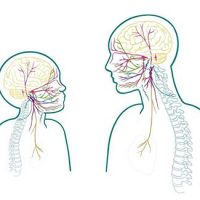Repatterning the nervous system through listening.
The music of the SSP has been filtered through a patented, evidence-based algorithm that highlights specific sound frequencies that help regulate the autonomic nervous system and stimulate the vagus nerve.

Humans need social connection. We look for cues of safety in other people by reading their faces, body language and tone of voice.
Some people, including adults and children who have experienced really difficult life events, are living with illness or injury, have sensory, learning or developmental differences, such as autism, or for many other reasons, may miss or misinterpret these cues as threatening.
Their autonomic nervous system may be biased toward experiencing the environment as unsafe, which can limit the body’s ability to heal and recover.
Auditory processing is a window into the nervous system. By listening to the specially filtered music of the Safe and Sound Protocol (SSP) in the context of a therapeutic relationship, the nervous system can be repatterned to better perceive calming frequencies, enhancing autonomic regulation by changing the way it responds to cues from the environment.
The SSP helps to regulate the autonomic nervous system and improve auditory processing, leading to better social connection.
When we experience the world as safe, we can more effectively and efficiently use our internal resources to support health and well-being, building the foundation for awareness, embodiment and resilience.

Humans need social connection. We look for cues of safety in other people by reading their faces, body language and tone of voice.
Some people, including adults and children who have experienced really difficult life events, are living with illness or injury, have sensory, learning or developmental differences, such as autism, or for many other reasons, may miss or misinterpret these cues as threatening.
Their autonomic nervous system may be biased toward experiencing the environment as unsafe, which can limit the body’s ability to heal and recover.

Auditory processing is a window into the nervous system. By listening to the specially filtered music of the Safe and Sound Protocol (SSP) in the context of a therapeutic relationship, the nervous system can be repatterned to better perceive calming frequencies, enhancing autonomic regulation by changing the way it responds to cues from the environment.
The SSP helps to regulate the autonomic nervous system and improve auditory processing, leading to better social connection.
When we experience the world as safe, we can more effectively and efficiently use our internal resources to support health and well-being, building the foundation for awareness, embodiment and resilience.

What this means for you and your clients:

Providers report that the SSP “opens up” their clients and relaxes their defenses, improving accessibility.

As a result, clients often experience quicker progress, becoming more engaged in therapy.

The SSP helps accelerate results and improve therapeutic outcomes.

Once integrated, the SSP often becomes an essential part of a clinical approach.
Impactful, long-lasting results for your clients are possible.

The Science of Safety
By sending cues of safety through specially filtered music, the SSP engages a system of muscles and nerves that support social engagement, stimulating the vagus nerve. This opens the door for other therapies to become more accessible, impactful and accelerated.
The Autonomic Nervous System
The autonomic nervous system controls the body’s most essential physiological processes, including heart rate, breathing, digestion, and bowel and bladder function. These systems are primarily working automatically, beyond conscious awareness or control. Autonomic state is guided primarily by the vagus nerve (CN X), which serves a key role in communicating information between the brain, body and environment.
Neuroception
Neuroception (different from perception) is a subconscious process of the nervous system in which it evaluates cues from the environment as safe, dangerous or life-threatening. The balance of these cues triggers a corresponding autonomic response, which influences how we feel, think and connect with others.
Auditory Processing
Auditory processing is the receipt, integration and interpretation of acoustic energy, and is closely linked to other sensory, central and autonomic nervous systems.
Accurate and discriminatory perception of sound is dependent on the function of the middle ear muscles, which tighten the tympanic membrane (eardrum) to support the perception and attenuation of certain frequencies. The middle ear transfer function is connected to a network of cranial nerves that contribute to the integration of sound with other sensory inputs in the brainstem, leading to cognitive, behavioral and physiological responses. The auditory processing system is a portal that fundamentally changes the way we experience and respond to the world.
The Social Engagement System
The social engagement system is an integrated system of cranial nerves and structures of the face and head that enable social behaviors like facial expressions, head-turning, speaking and listening, alongside coordinating essential functions like swallowing, chewing, nursing (infants) and regulation of the heart and lungs. This system has a bidirectional relationship with the cortex and brainstem, where sensory information converges and is processed from the internal and external environment. Through the lens of Polyvagal Theory, the social engagement system evolved to enhance the ability to communicate, collaborate, and build trusting relationships with others from a neurological foundation of safety.

Tunes that retune.
The SSP uses a wide variety of music, including some that you may already be familiar with. All the music in the SSP playlists are thoughtfully sequenced and filtered through the patented, evidence-based algorithm backed by decades of scientific research.

This visual shows full-spectrum sound frequencies in a typical unfiltered clip of popular music.

Here is the exact same clip — after being filtered through the SSP’s algorithm.
With three pathways, or levels of filtration, and five playlists that include vocal and non-vocal music to appeal to a wide range of audiences. you can create a customized program and listening experience guided by your client’s needs, presentation and desired outcomes.
Together, clinical trials and real-world evidence create a powerful and holistic evidence base for Unyte programs.
Real-world evidence. Real change.
Discover the science behind the transformative power of the Safe and Sound Protocol. Explore real-world case studies demonstrating the wide-ranging impacts of nervous system regulation. View all Case Studies →
Clinical Trials
The SSP’s effectiveness has been proven in a wide range of clinical studies, including clinical trials involving children and adults with autism. View all Research →
Get started today!
You must be a qualified professional to deliver the SSP. SSP Training and Certification covers both theory and the practical application of the Safe and Sound Protocol. Once certified, a subscription is required to deliver the SSP to your clients.
Annual Monthly Subscription
Pay monthly
$139/month
12-month subscription, billed monthly, auto-renewal.
+ $349 $249 one-time purchase of SSP Training and Certification
Annual Upfront Subscription
Pay annually and save!
$125/month
$1,499 today, billed annually, auto-renewal.
+ $349 $249 one-time purchase of SSP Training and Certification
Have questions? We’re here to guide you!
Book a free, personalized consultation or call us directly at 1-866-594-9453.







 © 2025 Unyte Health US Inc.
© 2025 Unyte Health US Inc.